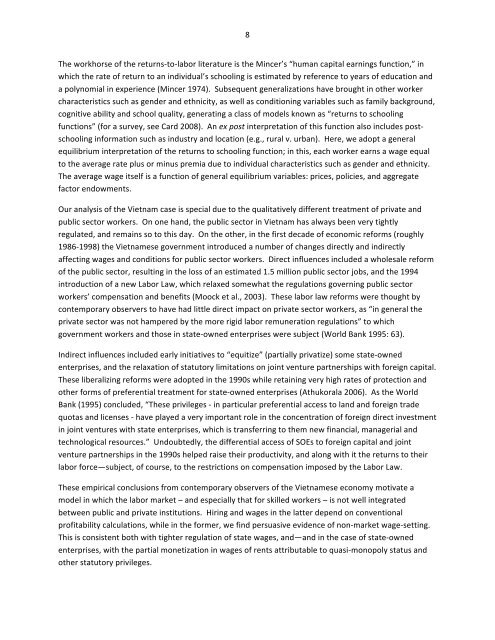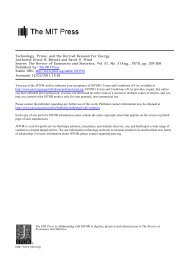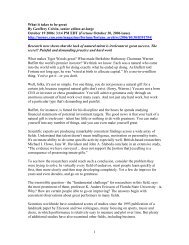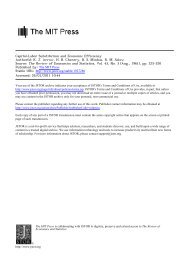Phan Coxhead Vietnam Wage Paper April 14 2011 - Agricultural ...
Phan Coxhead Vietnam Wage Paper April 14 2011 - Agricultural ...
Phan Coxhead Vietnam Wage Paper April 14 2011 - Agricultural ...
You also want an ePaper? Increase the reach of your titles
YUMPU automatically turns print PDFs into web optimized ePapers that Google loves.
8<br />
The workhorse of the returns-‐to-‐labor literature is the Mincer’s “human capital earnings function,” in<br />
which the rate of return to an individual’s schooling is estimated by reference to years of education and<br />
a polynomial in experience (Mincer 1974). Subsequent generalizations have brought in other worker<br />
characteristics such as gender and ethnicity, as well as conditioning variables such as family background,<br />
cognitive ability and school quality, generating a class of models known as “returns to schooling<br />
functions” (for a survey, see Card 2008). An ex post interpretation of this function also includes post-‐<br />
schooling information such as industry and location (e.g., rural v. urban). Here, we adopt a general<br />
equilibrium interpretation of the returns to schooling function; in this, each worker earns a wage equal<br />
to the average rate plus or minus premia due to individual characteristics such as gender and ethnicity.<br />
The average wage itself is a function of general equilibrium variables: prices, policies, and aggregate<br />
factor endowments.<br />
Our analysis of the <strong>Vietnam</strong> case is special due to the qualitatively different treatment of private and<br />
public sector workers. On one hand, the public sector in <strong>Vietnam</strong> has always been very tightly<br />
regulated, and remains so to this day. On the other, in the first decade of economic reforms (roughly<br />
1986-‐1998) the <strong>Vietnam</strong>ese government introduced a number of changes directly and indirectly<br />
affecting wages and conditions for public sector workers. Direct influences included a wholesale reform<br />
of the public sector, resulting in the loss of an estimated 1.5 million public sector jobs, and the 1994<br />
introduction of a new Labor Law, which relaxed somewhat the regulations governing public sector<br />
workers’ compensation and benefits (Moock et al., 2003). These labor law reforms were thought by<br />
contemporary observers to have had little direct impact on private sector workers, as “in general the<br />
private sector was not hampered by the more rigid labor remuneration regulations” to which<br />
government workers and those in state-‐owned enterprises were subject (World Bank 1995: 63).<br />
Indirect influences included early initiatives to “equitize” (partially privatize) some state-‐owned<br />
enterprises, and the relaxation of statutory limitations on joint venture partnerships with foreign capital.<br />
These liberalizing reforms were adopted in the 1990s while retaining very high rates of protection and<br />
other forms of preferential treatment for state-‐owned enterprises (Athukorala 2006). As the World<br />
Bank (1995) concluded, “These privileges -‐ in particular preferential access to land and foreign trade<br />
quotas and licenses -‐ have played a very important role in the concentration of foreign direct investment<br />
in joint ventures with state enterprises, which is transferring to them new financial, managerial and<br />
technological resources.” Undoubtedly, the differential access of SOEs to foreign capital and joint<br />
venture partnerships in the 1990s helped raise their productivity, and along with it the returns to their<br />
labor force—subject, of course, to the restrictions on compensation imposed by the Labor Law.<br />
These empirical conclusions from contemporary observers of the <strong>Vietnam</strong>ese economy motivate a<br />
model in which the labor market – and especially that for skilled workers – is not well integrated<br />
between public and private institutions. Hiring and wages in the latter depend on conventional<br />
profitability calculations, while in the former, we find persuasive evidence of non-‐market wage-‐setting.<br />
This is consistent both with tighter regulation of state wages, and—and in the case of state-‐owned<br />
enterprises, with the partial monetization in wages of rents attributable to quasi-‐monopoly status and<br />
other statutory privileges.







